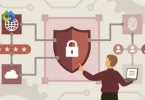It requires robust endpoint defense strategies. Let’s explore why these defenses are crucial and how they can shield your web team from evolving cyber risks.
Table of Contents
Table of Contents
Understanding Endpoint Defense for Web Teams
Endpoint defense involves protecting devices that connect to a network. It covers laptops, smartphones, and tablets that developers use daily. Each device represents a potential entry point for cyber threats.
For web teams, endpoint security ensures safe development environments. It shields sensitive data and code from unauthorized access. This layer of defense complements existing server protections.
Incorporating endpoint solutions reduces vulnerability. With strategic implementation, teams can safeguard projects from evolving threats effectively.
Common Threats Facing Web Developers
Web developers encounter various cyber threats in their work. Info-stealers can infiltrate devices to harvest sensitive information, posing significant risks.
Malware like RedLine or Vidar targets credentials stored in browsers or IDEs. Once stolen, attackers can access production systems or developer tools with ease.
Supply-chain attacks add another layer of concern. Compromised npm packages or poisoned GitHub repos can inject malicious code into builds. Without endpoint defense, threats spread silently across environments.
Comparing Endpoint Defense to Server Hardening
Server hardening focuses on the backend, which entails securing configurations, limiting access, and closing unnecessary ports. It locks down the production environment from external threats.
Endpoint defense, in contrast, protects the machines where code gets written and tested. A developer’s laptop can become a gateway for attackers if left unguarded.
Both strategies serve different layers. Server hardening fortifies what gets deployed, while endpoint security protects who’s doing the deploying. Each one fills a gap the other leaves open.
Essential Security Tools for Developers
Security tools need to fit the workflow without slowing it down. Endpoint Detection and Response (EDR) tools offer real-time monitoring, while staying lightweight enough for development machines.
Backups play a key role, especially versioned ones that cover local files and configurations. Combined with regular OS patching, they help reverse damage after an attack.
Some tools bundle anti-malware with automated backup. For cross-platform teams, that means fewer moving parts. You can learn more about this anti-malware software from vendors offering unified endpoint protection.
Implementing Lightweight Controls for Protection
Lightweight doesn’t mean ineffective. EDR tools can run quietly in the background, flagging suspicious activity without draining resources or interrupting workflows.
Versioned backups let teams restore environments after a compromise. Local copies matter as much as cloud storage when ransomware locks down access. Isolation of dev, staging, and prod helps contain issues early.
Routine patching keeps operating systems resistant to known exploits. Combine these elements, and the stack stays resilient without piling on complex infrastructure or management overhead.
Final Remarks
Endpoint defense shapes how web teams protect the tools that shape the web itself. Security grows stronger when safeguards are built into the daily rhythm of development, not treated as an afterthought.
Every device, every connection, every backup becomes part of a larger shield. The question is not whether to act, but where you will begin expanding protection next.














